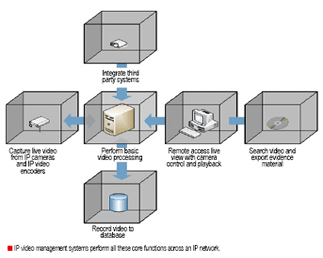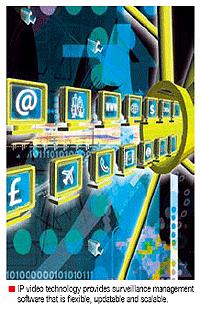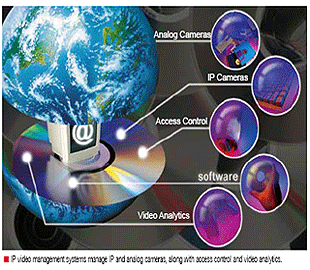This article presents a strategy for managers and organizations to systematically evaluate IP video management solutions. It explains what an IP video management system is and provides a list of criteria in selecting such systems.
This article presents a strategy for managers and organizations to systematically evaluate IP video management solutions. It explains what an IP video management system is and provides a list of criteria in selecting such systems.
The benefits of Internet protocol (IP) technology are driving a major change in the video management and surveillance fields. Organizations are interested in IP video surveillance for high-quality recording, fast search and retrieval, easy maintenance, and freedom from dealing with tapes.
They are also attracted to networking capabilitieseverything from ability to integrate with other security equipment and business systems to simplicity in running multiple cameras on the same network to cover larger areas more efficiently.
Not all IP video surveillance and management systems are the same. The rush to embrace IP technology has led some vendors to offer composite products that consist of a mix of IP and analog technology patched together with software. This has resulted in gaps between what is claimed and what these products actually deliver. This is particularly evident in the software designed to help users manage and operate the solution.
What is IP Video Management?
IP video technology provides video surveillance management software that is flexible, updatable and scalable. The ideal IP video management system provides intelligent software for day-to-day operation of video surveillance hardware on an IP network with the opportunity to integrate other components of corporate security programs.

Core functionality of ideal IP video management systems includes all of the following:
1. IP video management systems that simultaneously manage IP cameras and analog cameras together to capture live video with the analog cameras connected through video servers or encoders, converting analog video into digital format. More than 200 different IP cameras from more than 30 vendors can be connected to capture live video, all through the same user interface. Such systems also perform basic video processing like motion detection.
2. Systems that start recording in response to any of the following triggers: Motion detection Doors opening Rules in the software interface
3. Systems that also provide remote access that allows users in different parts of a building to see live camera views with complete control (pan, tilt, zoom). Other remote capabilities include retrieval and playback of video from archive databases.
4. Those that integrate with access control and video analytics. When people enter buildings, an access control system can trigger the video management system to verify that the image of the person captured from video matches the ID card and system.
5. IP video management that comes with ability to search video archive databases (by area of interest or time period), creating a secure export of material evidence to pass onto police or other authorities.
NINE Criteria for IP Video Management Solutions
The following nine criteria are important in facilitating a systematic evaluation of an IP video management solution:
1. Reliability
Reliability is essential to any video surveillance system. The main characteristics of a proven, reliable IP video management system are as follows:
Proven in daily production
Look at the solution's installed base and customer testimonials, preferably from businesses similar to yours. Both are indications of solid performance in the field.
Stable operation 24/7/365
Ask for data to support system reliability claims.
Robust in different network environments
Verify that the solution performs in different network environments, 100-megabyte or one-gigabyte networks, as well as a wide area network (WAN), in real, live situations.
Smooth software upgrade path
Software upgrades are an important part of the software lifecycle to keep up with new devices, drivers and operating systems. Make sure that the system can implement software upgrades without requiring that all hardware components be reconfigured.
2. Openness
Look for a system that can connect and integrate many technologies based on an open software platform and industry standards. Some of the ways to determine openness are as follows:
Well-documented software development kits (SDK)
The SDK should include a rich, easy-to-use application programming interface (API) that supports the most common programming languages.
Input and output support
Can you measure inputs in the software? And react to those inputs to trigger events and alerts, as well as activate outputs?
Event management
Event management enables custom settings for image uploads, alarm notification, recording, input and out (I/O) control, and other features in response to events.
Support for standard protocols
This is key to maintaining independence from any one vendor. Surveillance solutions built on proprietary systems can exclude you from future technology innovations that occur within the industryespecially those that you cannot envision now.
3. Flexibility
In today's business environment, change happens faster and faster, making flexibility more essential than ever before.
Security requirements are not static
Expansions, relocations, mergers, new regulations or advances in technology all force change on your security solution. A solution that has the flexibility to adapt to changing needs of organizations can save you money and increase return on investment (ROI) in the long term.
Choose standard components
Select standard servers, switches, storage hardware, software and surveillance hardware (cameras, access control).
 4. Innovation
4. Innovation
IP technology has been established as the future carrier for surveillance and access control. Creating a successful solution requires a new type of vendor that has skills in both physical security (positioning cameras, lens selection), and IT and network infrastructure (Ethernet, structured cabling, system management). Leading manufacturers are building this new channel by helping partners acquire these new skills through certification and training.
Research and development
Protect your company's future and avoid legacy solutions by verifying investment in research and development in each supplier that you consider.
Pace of development
Does your potential supplier have a documented roadmap for future upgrades? Do these upgrades represent significant increases in functionality that will help you leapfrog your competitors or are they bug fixes?
Product maintenance agreements (PMAs)
A PMA reduces cost of keeping your solution up-to-date as new software upgrades are released. The cost is usually a small percentage of product price, and can be paid on a yearly basis or upfront. A well-thought-out PMA program will extend the life of your solution, and significantly increase your ROI.
5. Scalability
Scalability ensures ability to expand your system in sync with company needs. For example, adding new buildings to accommodate increases in staff may require an upgrade from a single-server localized solution to a multi-server solution. Mergers and acquisitions often require upgrades to a distributed solution across several sites. Make sure that none of these will be a forklift upgrade.
Have channels to spare Implementing a single-server system that handles only 16 channels limits your options for growth. To expand with one more channel typically requires adding another server with a further 16 channels and having the two systems run side-by-side. With 17 channels, only 53 percent of the new hardware is being utilized initially. Implementing a solution that scales from one to an unlimited number of devices and one that grows smoothly in step with your needs is a more efficient approach that avoids duplication and under-utilization of hardware.
Old and new technology side-by-side
To protect your investment in hardware, your solution must incorporate new technology as it becomes available megapixel and day-night camerassideby- side with existing devices.
Anticipate extra data capacity
As your solution grows by adding cameras or specialized devices, demand for central processor units (CPU) and other resources on the video recording system increases. To maintain overall performance and fast response times, the system must be able to manage a distributed solution in which the load is shared across multiple, geographically separate servers.
Plan for future storage needs
At four frames per second with recording 24 hours a day, a single megapixel camera (100 kilobits per frame) requires 12 terabytes (TB, 12 x 106 megabytes) of storage during one year of operation. To manage storage capacity, you need to implement a company policy for archiving and storage from the beginning, for example, periodic archiving to CD or DVD. Always plan for overcapacity on storage from the beginning, and verify that the solution you implement can accommodate several types of storage solution and expansion options.
Supplier licensing schemes
Most surveillance solutions require a separate license for all devices on your system, as well as a new license for each additional device that you add. Clearly, licensing schemes can become complex and unwieldy. Ask potential vendors to demonstrate that their licensing scheme is simple and easy to manage, especially as you start to add new devices.
6. Easy Use
Solutions that are easy to use save time and money in both the short and long run.
Easy to learn
Ease of use is very important in situations where turnover is high and can have a direct impact on reducing training costs. Make sure that your vendor offers good training and that it is certified in installation and training.
Easy to install
Have the vendor demonstrate that installation procedures do not require multiple, manual steps on individual servers, for example, separate tasks to copy dynamic link library (DLL) files to each server. Look for push or pull deployment options that streamline the process of updating servers and clients.
Easy to manage
Your administrator should be able to manage from one central location without the need to go from station to station.
Simple, clear technical documentation
Does it consist of user guides (how to use the product) and technical reference manuals (quick reference on functions and procedures)?
Easy to operate
When things go wrong, there is usually no time to understand the system. Verify that common functions have one-click access and simple navigationeasy operation is vital for your employees to use the solution efficiently in daily tasks and maintain ability to respond fast.
 7. Performance
7. Performance
When you are recording multiple video channels, system performance depends on both software and hardware.
Remote access
To analyze an incident, you typically need to view multiple cameras using simultaneous, time-synchronized playback (all cameras playing back on the same time line). Ask your vendor to demonstrate how many cameras you can view on the same server in simultaneous, time-synchronized playback.
Network utilization
A one-megapixel camera at 10 frames per second requires approximately 10 megabits per second of bandwidth. If your surveillance solution requires many megapixel cameras, the server's network adapter can quickly become a bottleneck. Verify that you can easily configure the solution to share the load across multiple servers, switches and interfaces to maintain performance.
Connect multiple users
A typical surveillance operation requires multiple users to access live video from each camera. For example, in a citywide surveillance operation, many different users like police, firemen and ambulance personnel may need high-performance accesssay at 30 frames per secondto view video from each camera and usually different levels of access and control. In this real-life situation, the server can provide better performance to many users than could be achieved by connecting individual users directly to each camera. Given the debate about pushing functionality out to the edge of the network (meaning at the cameras), is this a better solution?
A camera typically has a small CPU and can handle a small number of channels. As few as three to five users accessing a camera simultaneously and requiring 30 frames per second can cause inconsistent levels of performance from the camera and may result in a significant performance drop for all users. A server, on the other hand, is designed to connect to large numbers of simultaneous users and deliver high performance to each one. The camera connects to the server using a single channel and is consequently never overloaded. The server can easily distribute video to many users, providing a consistent, high level of performance to each, even at 30 frames per second.
Unicasting vs. Multicasting
Unicasting streams video by sending separate packages to each user. However, the server sends packages to only users that are requesting the video; multicasting streams video by sending one package to all users on the network at the same time. Only those users who want video pick it up. If all users are viewing the same video at the same time, multicasting can appear as a good solution. However, consider the citywide surveillance example aboveit is more likely that many users who need to view different cameras at different times will be involved. This surveillance situation creates problems for multicasting solutions by sending all video streams to all users whether they are requesting it or not (depending on how routers are set up, video may even travel to remote IP subnets).
Even 10 to 20 cameras in a multicasting setup will take a great deal of bandwidth and can seriously affect system performance unnecessarily (considering that not all users may need access to the video from all cameras). Before implementing a multicasting setup, confirm that your solution needs simultaneous viewing from multiple clients.
Remote locations and mobile devices
Implement low-bandwidth optimization features such as image size reduction and adjustable frame rates. For low-bandwidth requirements, verify that the system can be optimized manually or automatically to reduce image size and adjust frame rates.
Fast access to the latest video
To reduce storage costs and capacity requirements, store only the most recent video on fast-access storage devices. As time elapses and video gets older, migrate your video archives from faster to slower disk storage systems. The older data becomes, the less likely it is that you will need to retrieve it for review.
 8. Integrity
8. Integrity
Here are some of the important factors to consider in managing access and maintaining data integrity in your solution:
Authentication and authorization
The solut ion should provide a role-based access to the system for all users based on the following: a. Authenticationverifying that users are who they say they are b. Authorizationmanaging and restricting access to features and data in the system Most surveillance solutions require that the administrator be able to determine which cameras a user can view and when.
Logging system
Verify that the solution provides a continuous log with time stamp so that you can trace activity and use of your system. You will need to set up procedures for your operators to audit these log files to assess if someone has tried to break into the system.
Encryption
Verify that the solution encrypts all data that is transmitted across unsecured networks. The encryption algorithm must be sophisticated enough to prevent network sniffers or wiretaps from being able to capture and decode confidential video, and secure data like passwords.
Secure, reliable evidence
Ask the vendor to demonstrate that video evidence that has been exported from the system is both encrypted and access-protected by passwords. It is important that the solution can validate that evidence has not been tampered with during the chain of custody. If tampering has occurred, you must be able to easily check integrity of evidence and identify when the tampering occurred and by whom.
9. Availability
To be effective, a video surveillance solution must be fully operational 100 percent of the time. In designing your solution, you need to plan for all contingencies, for example, power outages, hardware failure and system issues. Here are some of the requirements that you should consider:
Redundancy
Run hot, standby systems in parallel with your active systems that duplicate both hardware and software. Provide redundant power supplies and cooling from all servers and networking equipment.
Redundant array of inexpensive disks (RAID)
A RAID-5 setup provides redundancy in storage through parity striping. In this technique, each disk in the array duplicates enough data from the other four disks so that the complete data set on any of the five disks can be recreated if one fails.
Archiving and backup
In addition to your onsite archive, plan for long-term, off-site storage to enable fast data recovery after a catastrophe, like a fire in the server room.
Fail-over
The degree to which you implement fail-over in your solution depends on cost and business priority of data to be protected. Fail-over can be either cold or hot. A cold fail-over has a standby server that is offline and has to be powered up to take over. There is a chance that you may lose data during the time it takes to power up the standby server. A hot fail-over is where the standby server is powered up and online so that it can take over immediately, preventing any data loss. A potential drawback with a fail-over approach is that there may be gaps in data on the active system when it resumes control after repair. Verify that the fail-over strategy that you implement includes synchronization between all servers to keep the dataset intact.
Monitoring software
You can improve availability by employing software solutions that continually monitor status of all devices on your system. If there is a problem with any component, monitoring software sends an alert to a master control panel or via E-mail, enabling staff to respond quickly to rectify the problem. In response to an alert, the system can redirect a PTZ camera to continue surveillance in mission-critical areas where a camera has failed.